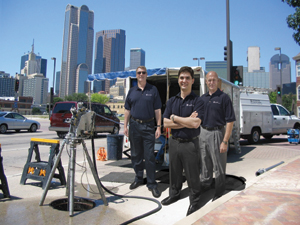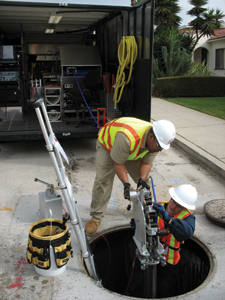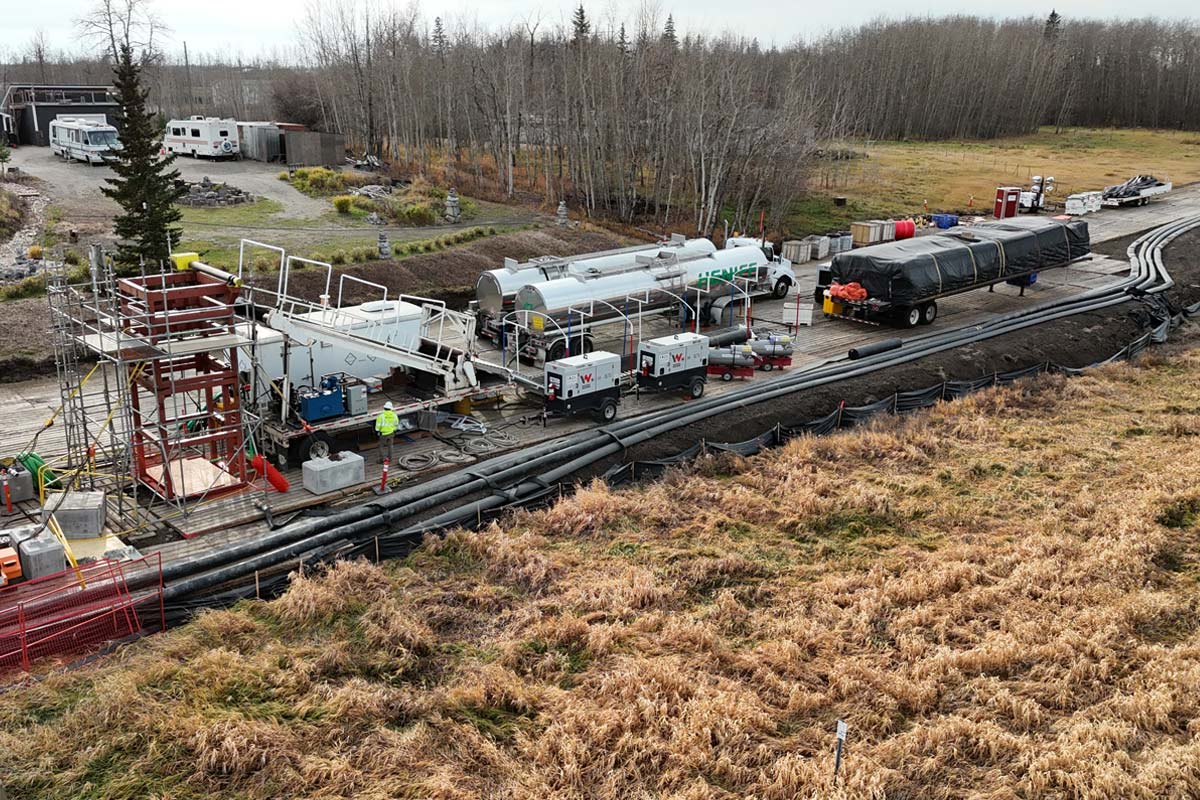Infrastructure Saving Solutions
June 1, 2008
 It’s no secret that aging infrastructure and the cost to replace that infrastructure are a huge challenge for the water industry. With populations increasing and available resources decreasing, it’s a no-brainer that water pipelines need to be in top-notch condition to make sure no water is lost.
It’s no secret that aging infrastructure and the cost to replace that infrastructure are a huge challenge for the water industry. With populations increasing and available resources decreasing, it’s a no-brainer that water pipelines need to be in top-notch condition to make sure no water is lost.However, maintaining water and wastewater infrastructure is not that easy. With not enough funds to fully replace pipelines, the next best step is to evaluate the state of the infrastructure and repair problems to bring a pipeline’s condition back to an acceptable level — and that’s where water pipeline inspection comes into play.
The Pressure Pipe Inspection Company Ltd. (PPIC) has been assessing the condition of pipelines and helping clients solve their infrastructure dilemmas for more than a decade. With the information PPIC provides, utilities and other water personnel can determine the condition of their infrastructure and make the necessary repairs before it’s too late and before a full replacement is needed.
“Our business is to help utilities bring their infrastructure back to where it needs to be without necessarily spending money replacing pipeline,” says PPIC president and CEO Brian Mergelas, Ph.D. “From a trenchless point of view, we’re able to get in, do an assessment of the pipe and supply information to the client. This way, they can make internal repairs in order to prevent total replacement. Once you get to the replacement stage, you’re going to need to excavate and spend more. By using our technologies, a client can avoid all of that.”
While pursuing his Ph.D. in physics at Queens University in Kingston, Ontario, Canada, Mergalas studied under Prof. David Atherton, who would help steer him toward his future career.
As an acknowledged expert in inspections of oil and gas pipelines, Atherton had been approached in the late 1980s by the water sector to examine some challenges with large diameter pre-stressed pipe rupturing, along with corrosion on the pre-stressing wires. From there, Atherton began his research and developed a new technology called Remote Field Transformer Coupling (RFTC). RFTC offered water supply system managers information on the location, distribution and number of wire breaks in their pipeline infrastructure.
Mergalas had gone to work in the oil and gas sector, where he headed up research and development for a pipeline inspection company. However, he eventually shifted his interests to water pipeline inspection after he became intrigued by the opportunities that both the industry and Atherton’s RFTC presented. After receving his Ph.D. and using RFTC as a base, Mergalas began PPIC in 1997 as a means to help utilities assess the condition of their infrastructure in hopes to preserve pipelines, save money and retain valuable water resources.
Supplying Solutions
With its original headquarters in Toronto, today PPIC has offices in Phoenix, Dallas and North Carolina, as well as subsidiaries in Peru and Mexico, offering its clients condition assessment of large diameter water and wastewater pipeline infrastructures — saving its clients money and protecting their vital water resources. The majority of PPIC’s work is done in the United States, with a number of significant projects overseas. Mergelas notes that most of the company’s business comes from areas with large populations that require the transportation of hefty volumes of water. Other areas include cities that are far from water sources and need large transition pipelines, especially in southwestern states such as Texas and California.
Since 1997, PPIC has brought onboard additional technologies and solutions to aid its clients in assessing their water pipeline infrastructure. In 2001, PPIC purchased Pipeline Technologies, a Phoenix-based company, in order to add acoustic monitoring to its list of services. This technology, called Acoustic Emission Testing (AET), is used to detect areas of active deterioration within pre-stressed concrete pipe (PCP).
By using AET technology, PPIC is able to identify pipes in active distress and notify clients about the potential failure of those pipes — allowing them to make the necessary repairs before a costly full replacement is needed.
Then in 2002, PPIC included a Geographic Information System (GIS) Asset Management platform to help its clients manage the information the pipeline inspection provides them. For example, GIS provides clients with an accurate map of its pipeline and asset management data about the pipeline, including risk analysis, cost analysis, work order management, report production and database querying.
More recently in 2004, PPIC brought over a technology from the United Kingdom, called the Sahara Leak Detection System, that was developed by the Water Research Center (WRc).This new addition provided a platform to assess all types of pressure pipe.
“The company uses Sahara for finding very small leaks in very large pipe. We use the Sahara’s findings as an indication of the condition for any type of pipe above 12 in.,” says PPIC chief operating officer Cliff Jones.
Along with those core services, PPIC also brings other technologies such as pressure transient monitoring, structural analysis and repair strategies to its clients to help them manage their water infrastructure.
“Our main business is to offer solutions to clients so they can understand what to do to manage their transmission system,” says Mergelas. “We have some technologies that we use as a core for that, but it’s how we combine those technologies that’s unique. Depending on the client’s particular needs and project, we perform the inspection and then tie everything together with the asset management. We have a suite of technologies, alliances and partnerships that allow us to address the assessment of pipeline infrastructure.”
Monitoring the Market
With the water industry discovering that there are not enough funds to properly replace its entire infrastructure, today utilities are relying on the pipeline inspection industry to uncover the condition of pipelines. Since these pipelines will be used for years and years to come, utilities and water personnel need to use technologies to assess the condition of their infrastructure and perform repairs to keep pipelines working effectively.
“About 30 years ago, the oil and gas sector started to get into the concept of life extension,” says Mergelas. “Instead of taking your pipelines and running them just for their design life, you recognize that you’re going to run them beyond design life. In order to do that, you need to check the pipeline faithfully and you need to know the condition of the pipeline.”
Mergelas adds that the same concept is present in the water sector as well, and the water and wastewater industry needs to take note of its infrastructure’s condition. If utilities plan to run infrastructure beyond its design life, either they must allocate funds to replace the pipeline or pay to use inspection technologies to get a view of the pipeline’s condition. From there, utilities then need to take appropriate actions such as fix the areas that require repair, or monitor areas that don’t need to be fixed right away.
With time and new technologies, pipeline assessment inspection has grown to become an accepted practice among people in the industry. For the last decade, utility personnel and others working to preserve their infrastructure are beginning to understand and utilize these technologies to assess the condition of pipelines and take the proper precautions in repairing any flaws.
“Over 10 years ago, before we entered the marketplace, if you talked to 10 different consultants you might get 10 different ideas on what you should do to assess the condition of the pipeline infrastructure,” explains Mergelas. “There wasn’t an obvious course of action that needed to be taken. Now, 10 years later, there’s a consensus on what it means to do an assessment of pipeline infrastructure and what the next steps are beyond doing the assessment.”
 However, one challenge PPIC and the water pipeline inspection industry is facing is utilities coming up-to-date on the technologies and services offered and adopting the practices of pipeline inspection.
However, one challenge PPIC and the water pipeline inspection industry is facing is utilities coming up-to-date on the technologies and services offered and adopting the practices of pipeline inspection. “Utilities are not normally accustomed to being proactive. I think utilities can sometimes have a reactive attitude,” says Mergelas. “On any given day, in any given city in the United States, there’s a field crew designated to fix leaks and main breaks and that’s what their entire job description is — to reactively repair problems. It takes a change in mindset to be proactively going out and identifying leaks and problems in the pipe before they manifest themselves and create breaks.”
Mergelas notes that the acceptance of water pipeline inspection and its approach to managing infrastructure has been a slow process that the industry’s been going through, but it is progressing. He also mentions that the development of new technologies to assess the condition of pipeline infrastructure is enabling utilities to manage water resources both in North America and around the world.
“Aging infrastructure is a global problem; it’s not just a local problem,” says Mergelas. “It’s not just something one city, one state or even one country is trying to deal with, so we believe that by bringing high-valued solutions to our clients, helping them save water and money by providing this information, that our solution becomes a global solution.”
Integrating Improvements
As PPIC continues to grow and assist clients in assessing their infrastructure, the company is constantly looking at new technologies to add to its suite of solutions, as well as discovering ways to improve its existing platforms. With a specific focus on networking and R&D, PPIC works toward extending its list of offerings and benefits to its clients.
“We believe there isn’t one silver bullet with the technology. We’re always interested at looking at new technologies to see if they make sense for our clients,” says Mergelas. “It’s understanding the client’s challenges and trying to take our existing platforms and build better technical solutions around those platforms.”
“PPIC networks with key industry players to see what challenges there are and what new technology solutions might help clients better manage their infrastructure. PPIC vice president of corporate development David Roy states, “Close cooperation with major engineering firms is vital to the industry utilizing innovative service solutions.”
Mergelas notes that internal research and development is important in order to create and expand enabling technologies that save money for the company’s clients and to refine the existing technologies PPIC offers. For example, the company recently introduced a new solution called PipeDiver, which delivers the RFTC solution into pipelines without the need to dewater the pipelines — allowing PPIC to do an inspection in fully operational pipelines.
On top of bringing in new technologies and working to perfect existing ones, Mergelas says that the company’s continued commitment to bring expertise, professionalism and a strong product to every project is at the core of PPIC’s success and development.
“It’s the level of professionalism we bring to every project that’s important,” says Mergelas. “It’s the strong performance and dedication to exceed the customer’s expectations. We have proven technologies and experienced technical people that give us the ability to put together solutions that address the specific needs of any client wanting to manage their infrastructure effectively.”
Pam Stask is an assistant editor of Trenchless Technology.




